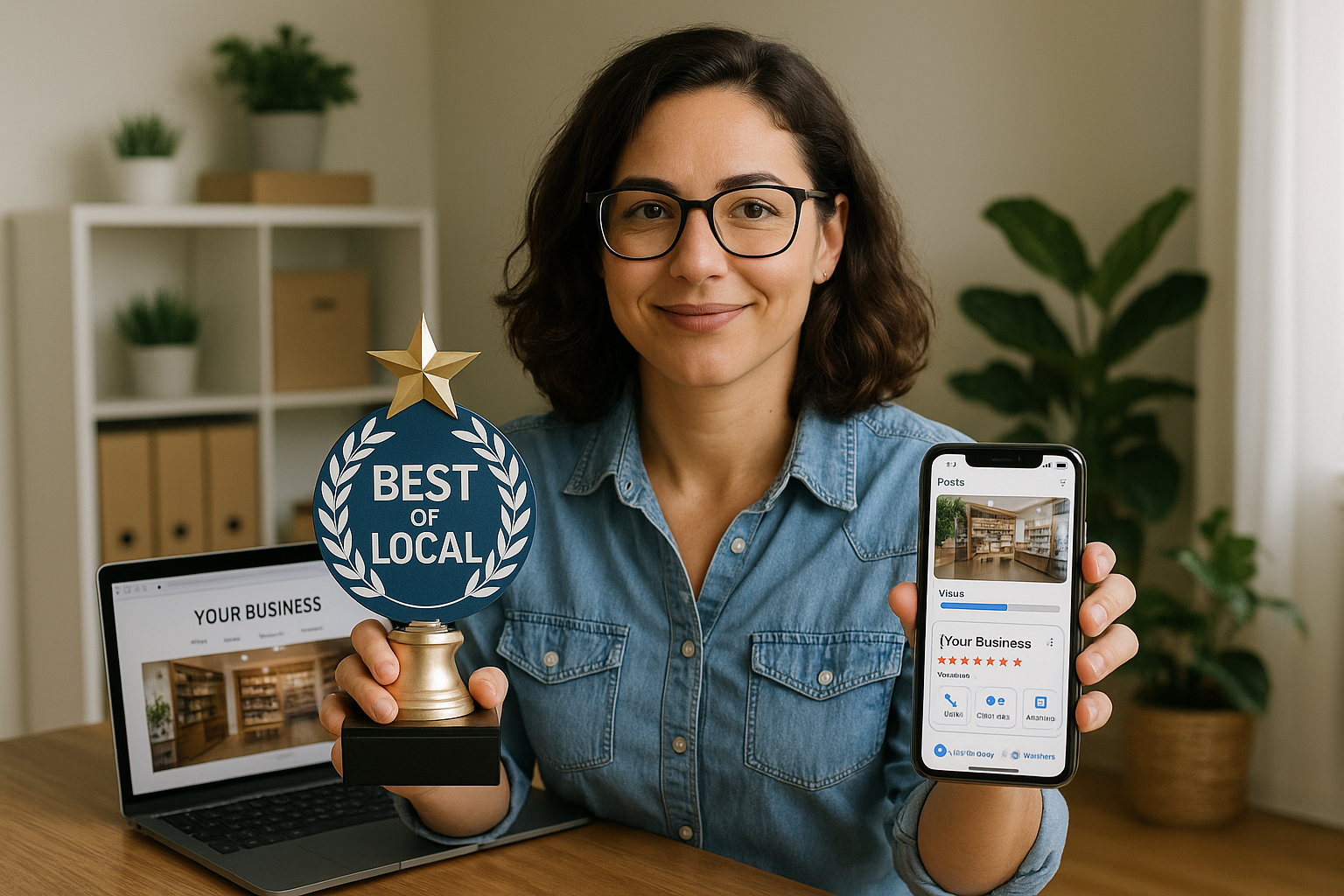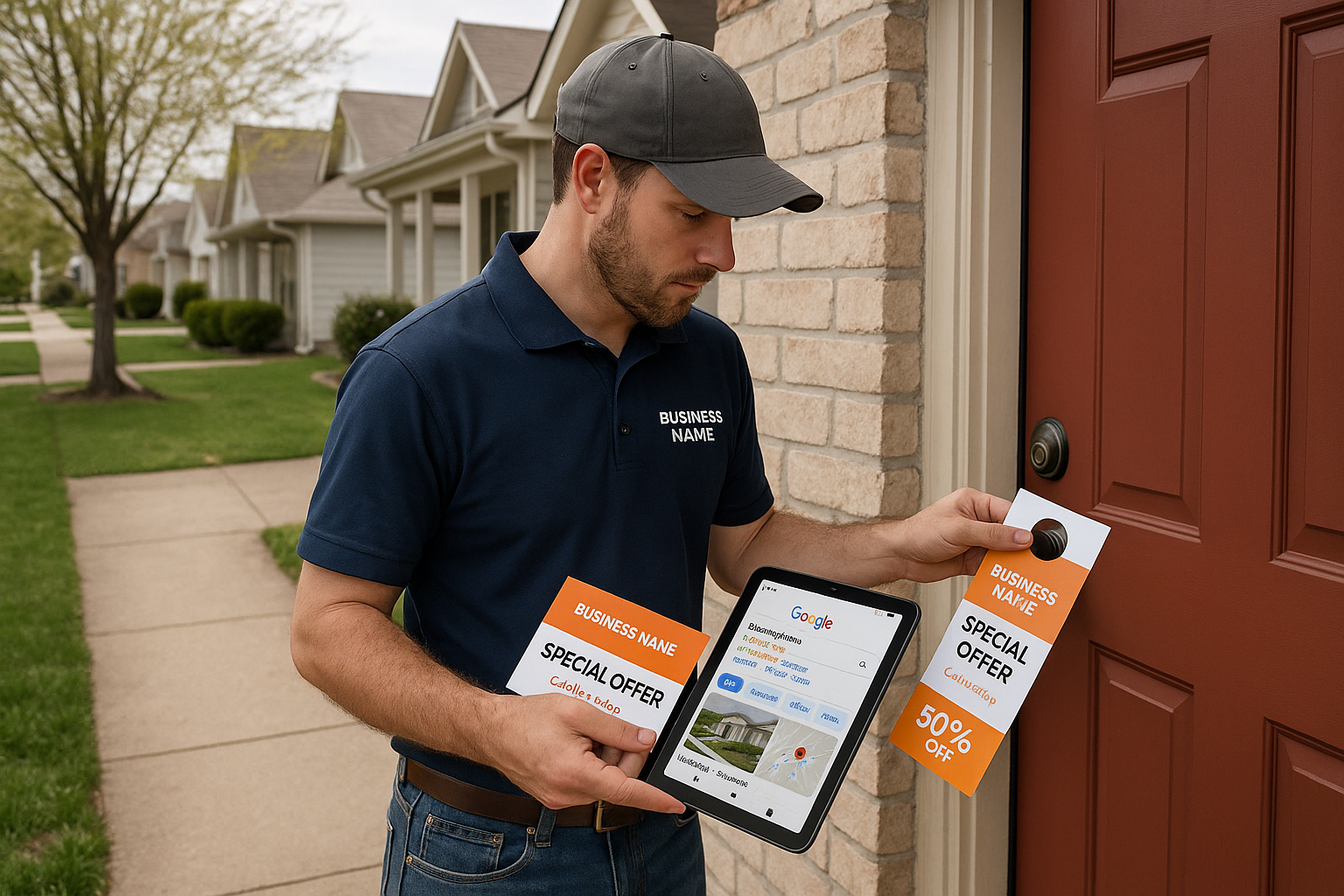If you are a small business owner who would love to see your name in a local paper or magazine without paying for ads, you are in the right place. This guide shows you how to get featured in local news with a straight to the point pitch template, plus the steps that turn that coverage into backlinks, trust badges, and real gains on your Google Business Profile. No fluff. No airy theory. Just practical moves your future self will thank you for.
I am the owner of Rep Lock Marketing, and I have been helping small businesses punch above their weight for years. Local press is one of the highest return plays in that punchy little playbook. You get reach, credibility, and the kind of local SEO boost money cannot easily buy. Editors get a story their readers care about. You get a link and a brag line for your website. Everyone wins. The only catch is you need a newsworthy angle and a short pitch that respects an editor’s inbox. That is exactly what you will find below.
To keep this useful for searchers, I will use the phrase how to get featured in local news where it makes sense. That phrase pulls readers into this resource and helps you find it again when you need it. Let’s get you press ready.
Why local press coverage matters
Local coverage feeds discovery, trust, and search gains in one shot. You get reach from the publication’s audience. You add social proof that tips buyers toward yes. Then you bank SEO value when you earn a relevant link from a trusted local domain. That trifecta is why smart owners treat PR like a sales asset rather than a vanity move.
From a search point of view, a mention from a city paper, neighborhood magazine, chamber site, or a school partner acts like a proof point about your authority and your place in the community. Search engines see that vote and it helps you climb for local intent queries. If you need a primer on the mechanics, start with our guide on how backlinks boost local SEO. That resource breaks down what types of links help most, why relevance matters, and how local sources stack up against random blogs that have nothing to do with your city.
Your profile on Google also benefits when you turn that story into fresh content and activity. Add the article to your photos and posts. Check your name, address, and phone in the article. Make sure the piece uses your correct details. That small step protects consistency, which is a quiet driver of trust in local search. For a quick refresher on getting the basics right, browse our Google Business Profile basics. You will find a clear rundown on what to track, what to post, and how to tighten your local signals.
Press works for human reasons too. People want proof before they buy. A line that says As seen in Eastside Magazine or Featured by Springfield Chronicle moves a reader from curiosity to comfort. Post that on your site. Add it to your proposals. Drop it in your bio. It becomes a trust badge for months or years. You can also show that feature to partners when you ask for collaborations. Social proof compounds if you stack it with smart asks. More on that below.
Find a newsworthy angle
Editors are not looking for your homepage in paragraph form. They want a focused story that fits their readers and their section. That means you need an angle. The easiest ones come from real activity in your city. Think partnerships, hiring with heart, fresh data that shines a light on a trend, or a new service that solves a timely local problem. This is not about being the biggest company in town. It is about being specific, timely, and helpful.
Sponsorships and events
Sponsorships and events are press magnets for a simple reason. They connect your brand to a community outcome. That makes a clean hook for local papers, schools, and neighborhood magazines. If you are weighing where to put your time, read our playbook on local sponsorships build trust. It shows how the right partner can help you earn mentions on event pages, school blogs, and city sites. Those links are pure gold for local authority. They are also easy to request because both sides benefit.
Events can be your own or a co hosted moment with a partner. A seasonal toy drive. A mobile pet adoption at your storefront. A first Friday tasting with a nearby bakery. The news hook does not need to be huge. It needs to serve a clear audience and offer a visual. Editors want photos and short interviews. Give them both. If you want a content rich event that stacks trust, this guide will help you host local events that lead to coverage, links, and referrals long after the last folding chair is put away.
Think like an assignment editor. Ask what the reader gets out of this and why it matters right now. Tie your event to a date on the city calendar, a season, or a local need. If weather risks shut down outdoor events in your town, pitch a quick indoor alternative. Give the outlet a reason to send a photographer or to grab your photos with clear permissions. That one detail can make or break a pickup when a newsroom is stretched.
Customer stories and milestones
People crave human stories. If your company just reached ten thousand customers served, that number carries weight when paired with a human angle. Maybe your team hired three graduates from a local program. Maybe you promoted someone from cashier to manager after a year. Maybe you hit a five year mark and celebrated with a give back day that helped a neighborhood cause. Editors love progress when it means something for people in their city.
Translate your milestone into a story readers can see. Add a face, a place, and a lesson. Instead of We grew revenue, try We trained and hired five first time techs through a partnership with the community college. Then show how that program creates outcomes for families in your zip code. Offer a short quote from the owner and a one sentence quote from a partner or customer. That is publish ready material for fast turn news sections.
Keep the pitch tight. Make the headline feel like a headline. Think Local roofing company hires graduates from South High trade program or Eastside cafe expands hours to meet weekend demand. Handle proof with one specific detail. Handle timing with a date, a ribbon cutting, or a simple photo opportunity. If you help an editor visualize the story, the odds of a yes climb fast.
Data or trends
Local data travels far because it gives a reporter something fresh to cite. You do not need a giant survey to pull this off. You can poll two hundred customers about a simple choice. You can pull three months of before and after service results from your own jobs. You can track quotes and calls tied to a weather event. When you publish a clean takeaway, it gives editors a reason to call you for comment now and later.
Make your data easy to grasp. Use one main stat with a short sentence about what it shows and why the community should care. Add a chart or photo on your site and give editors permission to use it. Mention that the visual is available in your pitch. If you are worried about how to label your image files, alt text, and captions for search and accessibility, keep it simple. Describe the image clearly with who, what, where, and when. That helps readers with screen readers and gives context for the story.
Pair data with a clear local tie. A heat wave leads to a spike in AC repairs. A hail storm pushes roof inspections by fifty percent in a week. A new bus route lifts foot traffic on your block. Data that lives in the city makes your story more than a company update. It becomes a community pulse check.
Build your short media pitch
Editors sort through a lot of email. Win their attention with a tight subject line and a two sentence body that gives the who, what, where, when, and why in plain language. Then offer photos and a quick phone interview. Do not copy your full press release into the email. Keep it short. If they want more, they will ask. You can attach a one hundred word release for editors who like a little extra detail. That style respects their time and improves your odds.
Subject line options for different angles. Pick one based on your story.
[City] [Business] partners with [Group] to [news hook]
Local [type of business] launches [newsworthy item] for [section or audience]
Story idea. [One line hook such as Neighborhood bakery hires ten formerly incarcerated bakers]
Copy and paste pitch template for your email.
Subject: [Choose one subject from above]
Body: Hi [First name]. I am [Name], owner of [Business] in [City]. We are doing [one sentence news hook with what happened, when it happened, and why readers care].
We have [data point, quick visual, strong local tie, or a human story] and we are available for interviews or on site photos this week. Would [Publication] be interested in covering this story. I can send a short press release and photos right away.
Close: Thanks for considering it. Can I send more info. [Name] | [Phone] | [Website]
Optional press release you can attach for editors who prefer a few more details. Keep it short and factual.
Press release sample: [City, State, Date]. [Business] announced [what happened] at [location] to support [community goal or customer need]. The effort will [brief result or benefit]. Photos and quotes are available upon request. Media contact. [Name, Title, Phone, Email]. About [Business]. [One sentence about what you do and who you serve].
That is the entire pitch strategy in three parts. A clear subject that sounds like a headline. A single sentence that delivers the hook. One offer that makes the editor’s job easier. When you repeat this format, you train your team to pitch like pros without hiring a PR agency.
Outreach sequence and timing
Great pitches still need structure. Treat outreach like a micro campaign. Line up your list, schedule your sends, then follow up twice with short notes. If you can, call the news desk or the right editor for thirty seconds to confirm who owns your section. Many placements happen because you found the right person at the right time.
Start with a small list that fits your story. City news desk. Neighborhood magazine. Local business journal. School paper if your story ties to students. A community blogger who covers your district. Look for bylines on similar stories and send to that writer. Respect beats. If someone covers food, do not pitch a roofing story. Keep a spreadsheet with the outlet, name, role, email, and notes on what they like or avoid. That record will save you hours next time.
Timing matters. News desks tend to fill their weekend sections by midweek. Morning inboxes are crowded. Early afternoon can be a sweet spot. Do not stress about the perfect minute. Stress about clarity. Subject lines that read like headlines get opened. Body copy that helps the editor file a strong piece gets replies.
Follow up email number one. Send this forty eight to seventy two hours after the first pitch.
Subject: Quick follow up. [short hook]
Body: Hi [Name]. Just checking to see if the [hook] story is a fit for you. We can do a quick phone interview and can provide a photo within a few hours. If you prefer a different contact, can you point me to the right editor. Thanks, [Name]
Follow up email number two. Send this seven days after the first follow up.
Subject: Final note. [hook]
Body: Hi [Name]. One last quick note on the [hook]. If now is not the right time, would a different angle help. We can frame it around community impact, a data takeaway, or a human profile. Happy to adapt. Thanks, [Name]
Phone script for a short call. Keep it under a minute.
Hi [Name]. I am [Name] from [Business]. I emailed you a local story idea about [thirty word hook]. We already have photos and a short release. Can I email it to you, or is there someone else I should send it to.
Be polite. Be brief. Thank them either way. A no today can turn into a yes next month if you stay useful and easy to work with.
Turn coverage into SEO and GBP wins
The story goes live. Great. Now you turn that win into compounding value for search and sales. Most owners stop after the post goes up. That leaves half the upside on the table. Use this section as your next day checklist.
First, ask for the link. Reply to the reporter with thanks and request a link on your brand mention. If they need a page to link, point them to a press page or your main service page. You can borrow this short note. Subject. Thanks and a quick request about the story. Body. Hi [Name]. Thank you for the great piece. Quick favor. Could you link the mention of [Business] to [your preferred URL]. Also, what is the live URL so we can add a link on our site and share. Appreciated. [Name]. Keep it friendly. You are not nagging. You are helping them finish the credit the right way. That link passes real value. If you want the deeper why, that is covered in our guide on how backlinks boost local SEO.
Second, check your details. Open the story and look at your business name, address, and phone. If anything is off, send a polite correction. That keeps your listings consistent and prevents confusion for customers. Add a line that says you are grateful and that you want readers to reach the right number. Small courtesies like that turn first time coverage into a long term relationship.
Third, add the feature to your site. Create a simple Press or In the News page if you do not have one yet. Post the publication logo with a short excerpt and a link. Use a clean alt text that names the outlet and the subject. For example, Owner Carla at Austin Film Block Party handing check to local nonprofit in Austin. Add a line on your homepage near your reviews that says As seen in followed by the logo. That little badge can lift conversion on service pages where buyers hesitate.
Fourth, post the article to your Google Business Profile. Use a short summary in a Post and add a photo. Update your Photos section with a behind the scenes team shot. If you have a quick video from the event or interview day, share that too. Activity helps people find you in Maps and gives new customers a reason to call. If you want a quick refresher on how to tune your presence for local search, our Google Business Profile basics show the steps. You will find notes on posts, photos, and what to track in Insights.
Fifth, use the feature as a story anchor in your brand. Pull a line from the article as a quote and place it near a testimonial. Add the short story to your About page. Use it in sales decks to reduce friction. If you want help shaping the story so it reads clearly and connects with readers, take a look at our thoughts on brand storytelling. That piece shows how to frame your origin, your mission, and your proof in language that people actually remember.
Sixth, ask partners for links. If your story came from a joint event or a school partnership, ask them to include a link to your press page in their recap. Offer to send a two sentence summary and a photo. Make life easy for their webmaster. This takes five minutes and doubles your link count from one action.
Seventh, ride the wave and ask for reviews. Add a line on your new Press page that says Loved our feature. Leave a Google review to help neighbors find us. Time that ask within a few days of the story going live. You will often see a small spike in traffic and interest. Convert that interest into public proof.
These steps take less than an hour once you get the hang of it. They turn a good story into weeks of search gains, stronger sales pages, and a cleaner profile on Google. That is the difference between a one day blip and a durable asset.
Checklist and metrics that matter
Keep your process simple so you can repeat it without stress. A short checklist helps. Start by claiming and verifying your profile on the big platforms, place your story idea into a two sentence pitch, then sequence your outreach. When the link goes live, clean up your details, post to your profile, then track what moves in search and sales.
Short checklist you can save for later.
- Claim and verify your profile, then post photos and a short update tied to each feature.
- Choose a newsworthy angle. Sponsorship, event, data, or a human story that fits your city.
- Draft a two line email using the local media pitch template in this guide.
- Send one pitch, follow up twice, then make one short call to the news desk.
- When live, ask for the link, add the story to your site, then post to your profile. If you forget what to search for later, look for how to get featured in local news and you will find this guide again.
Measure a few core signals so you know what works. Track the number of new links and referring domains that point to your site. Watch your traffic from those articles for the first two weeks. Tag your press page links with UTM codes so you can see visits in analytics. Mark leads that mention the article in your intake form. Look for movement in your local keyword rankings in the weeks after coverage goes live. Check calls, messages, and profile views in Google Business Profile Insights. Press often produces a short burst of attention and a long tail of search gains. Watch for both.
Do not obsess over vanity numbers. You do not need a hundred outlets. You need a few great local sources that reach real buyers in your zip codes. Quality beats volume in local SEO and in sales. A single local magazine can drive calls for months if you turn that feature into a badge, a post, and a story on your site.
Quick case study Rep Lock EASTside Magazine feature
Rep Lock landed a local magazine feature that shows this strategy in action. Take a look at our local magazine feature example for a micro case that mirrors the process in this guide. We pitched a clean story that centered on community value, offered photos, and made it easy for the editor to say yes. The result was a piece that lived on the magazine site and in print. From there we asked for the link, added the story to our site with a clear logo badge, and posted a short note with a photo to our profile.
Traffic jumped that week. More interesting, the feature gave us a line in outreach to partners who had not met us yet. That line made email replies faster and call backs friendlier. The article became a proof point in proposals for clients who value local traction. It also fueled an ask for one more link from a partner who recapped the story and linked to our press page. That is how you stack value from one local feature.
Could you replicate this. Yes. Start with a clear angle. Use the template. Offer a photo. Follow up politely. Then work the post coverage steps until the story becomes a badge, a link, and a line in your sales process. That repeatable loop is the goal.
Resources to help you move faster
You now have a working plan to get featured, pitch with a short template, and turn wins into links and profile gains. If you want a deeper guide on local link value, local profile setup, or event and sponsorship tactics, browse our articles on backlinks, Google Business Profile setup, sponsorships, events, and storytelling on the Rep Lock site. Each one gives you steps you can put to work this month.
One final thought. Local press is not luck. It is a repeatable habit. Keep a simple calendar of city moments. Track which editors like photos, which prefer a quick phone call, and which sections publish reader friendly features on small businesses. Commit to one pitch each month. With a few round trips, you will collect links, stories, and a stronger local presence without buying ads. That is how small brands grow outsized authority with a smile and a little hustle.





